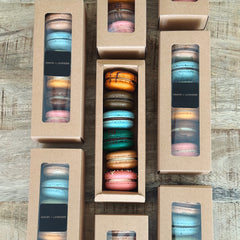CARING FOR YOUR PLANT
Adjustment period
Expect your plant to have an adjustment period when it gets to its new home. This is normal as it gets used to its new living conditions.
Some older leaves may yellow, some leaf tips may brown, and some leaves may drop off. Your plant also may start to grow lopsided or leggy as it reaches towards the light of a nearby window. Having been grown in the ideal conditions of a greenhouse, it’s unrealistic to think your plant will stay in the near perfect state you purchased it in. You can rotate, trim, and stake your plant to try to keep it tidy (see Loving Your Plant below).

These yellow leaves on this Ficus Moclame plant are normal while it's acclimating and during new growth periods.
When to water your plant
Determine an approximate watering schedule. We recommend you water your plant on a schedule which may change seasonally based on changes in light, temperature and humidity. The care card spells out your plant's specific watering needs.
1. Push your finger into the top inch or two of the soil (eyeballing the soil is NOT a good indicator of moisture).
2. As a general rule, if the soil is wet, do not water and check again in a few days. Plants don't like soggy soil.
3. When the appropriate amount of soil is dry (this is on your care card) THEN water.
After following these steps if you discover that the soil dries out 7 days after watering your plant initially, then you’ll be on a weekly watering schedule. Plants in low light or no natural light will need water less often. Without the help of sunlight, the soil will take longer to dry out.
How to water your plant
If your pot has drainage:
In general, we prefer to leave our plants in the plastic grower pot that is slipped into a decorative pot.
1. Remove the plant from the decorative pot and place the plant in the sink.
2. Saturate the soil (not the leaves, unless directed) and let the water drain into the sink.
3. Once drained place the plant back in the decorative container.
If your pot doesn’t have drainage:
For plants that have been potted directly into a decorative container, water more cautiously. Pour water evenly all around the soil until the soil seems moist to the touch (not soggy), but enough so the water will reach the roots at the bottom of the plant. You might want to use a liquid measuring cup so you can determine the best amount. If you pour too much water in, standing water can build up at the base of the plant and will lead to soggy, smelly soil and yellowing leaves.
Troubleshooting
Browning Leaves: After the initial acclimation period, browning leaves (especially at the tips or top of the plant) typically indicate under watering.
Yellowing Leaves: Yellowing leaves can indicate overwatering. Remember, it is normal for plants to have some yellow leaves, especially when they are acclimating to a new spot, or during their growth season when they shed older, lower leaves to maximize energy for new growth.
If you are experiencing yellowing leaves or sections of the plant rotting out, instead of saturating the soil when you water, just water until the soil is moist.
Loving your plant
Now that you’ve found the right light and determined how to water, here are things you can do to occasionally to show your plant some love:
Rotate: Turn your plant so it will grow evenly, as it will want to grow toward the light.
Dust the leaves: Wipe the leaves with a wet cloth so the dust doesn’t prevent the light from getting to the leaves.
Trim and shape: Cut brown leaves, brown tips, or yellow leaves off the plant so the plant can focus its energy on healthy new growth. You can also try to shape your plant by cutting off sections of new growth if it’s getting too big for your liking. Use a stick or a bamboo stake to prop up a heavy limb or trunk that’s not growing straight.
Aerate the soil: Take a chopstick or similar sized object and carefully poke holes in the soil so that the water can get through properly. Over time, especially with less frequently watered plants like cacti and succulents, the soil gets so hard and compacted that the water runs around the soil instead of soaking in.
Mist: If your care card indicates that your plant likes humidity you can mist the leaves periodically. Another way to add humidity to your plant’s environment is to set the plant on a tray of pebbles and water.
Fertilize: Fertilize according to the instructions on the package. Typically, this is only during spring and summer, the plant’s main growth period.
Repot: Repot when you can see roots growing out of the bottom of the pot, or if the plant looks too big for the pot, or is falling over because it is too heavy for the pot. Typically it’s recommended to repot once a year but we’ve been known to let our plants go much longer and they are just fine. For large floor plants you can also just add some new soil to the top of the planter instead of wrestling to repot a large plant.
Plant Care Resources:
Specific Care Instructions by Plant Type
How to Get Rid of Common House Plant Pests

